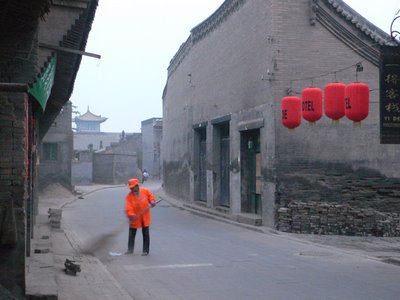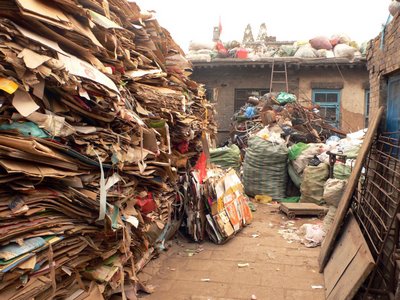
the crack of dawn, a dusty street cleaner, Pingyao
I flew half way around the world the other day to reach an old Chinese city where for every one of the last half dozen years, a big photographic festival has been held. Pingyao (sounds Chinese, right?) is about an hour’s flight plus a 50 minute drive from Beijing, an older city which dates to the Ming Dynasty. The 30 foot high walls which snake around the town presumably protected its well known financiers and merchants from plundering hordes, until such time, that is, that the plundering hordes brought with them a 31 foot section of ladder. It is said that Marco Polo passed through the city, presumably on his successful quest to have an annoying swimming pool game named after him. And at dinner tonight, the “Pingyao” noodles, bathed in tomato sauce, reminded me of Pici, the hand thrown pasta found in central Tuscany, and which version I think probably still surpasses the original. But you have to give them credit, when they decide to throw a get-together, you really DO get together.
CONTACT, my photo agency, in the midst of its 30th year, was invited to take over a space on the edge of the old city which was once the Diesel Engine repair shops. Suffice to say that it’s probably riddled with dirt and dust which OSHA would find wanting. Yet, within those giant spaces (the ceilings are 40+ feet high), when cleaned up, a venue was laid out for an amazing show. Instead of transporting the 500 prints which are on display, we did it the new, efficient (kind of), digital way. Scans were made in New York, and dvd disc s flown to Beijing, where they were printed locally on the latest Epson printers.

Contact/Contacts at 30
The cornerstone of the show is Contact/Contacts/30: 30 enormous contact sheets (approximately 9x12 feet) shot by two dozen photographers over the past three decades, and next to them a smaller print of the one “select” picture from that contact sheet. For those who never got your fingers wet in the darkroom – a contact sheet is the elemental building block in silver photography: you cut your strip of film into 3s or 5s, and lay them out on a sheet of 8x11” paper, and shine light through it. It makes a positive on the paper, when developed, and shows you in perfect time-line exactly what your pictures are going to look like.
Sometimes there are good surprises, and sometimes bad ones. In the olden days, you know, a couple of years ago, and stretching back more than 140 years, you would process your film, make the contact sheet, and study what you had; later, prints of the “selects” or favorites would be made. You had a limited number of shots (36 if it were 35mm film) and you had to plan ahead during your shooting, always TRYING to leave a little bit of the end of the film, ready for that surprize, unplanned moment. (The day I met Iris in 1979 – our REAL Anniversary -- I broke all my rules: Sadat, Begin and Carter were signing the Camp David accords at the White House, and I was the “pool” agency representative. In the excitement of seeing them sign the document, I shot like a madman, taking dozens of shots in the four cameras strewn across my shoulders and neck. When they finished signing, they stood up and grasped hands together, rather like Little League ball players holding a bat to see who would be Up first. That was THE moment of the day. And it was also the moment that I realized I was out of film, totally, in four cameras. I tried rewinding so I could reload quickly, but I was too late. It was a dark day, and Iris found my humor later that night, dinner at Germaines, to be wanting. Hey, I was bummed out from my “out of film” experience. Our romance nearly didn’t get off the ground.)
Now, with nearly untold possibilities in shooting on digital cameras (you can get 300+ shots on a memory card), you not only lose track of the tightness and discipline of the 36 exposures, you get lazy and risk shooting so much that you’re busy wasting precious memory card space when you could easily opt to shoot shorter, tighter sequences. So that is my story, film wise, and I’m sticking to it. In Pingyao, the contact sheets (normally 8x11”) in the show are nearly 12’x 9’. (Yes, it’s bigger than a lot of family sized camping tents.) So, as we lunge into the digital future with all its temptations and rewards, it’s nice to see what those contact sheets look like, and to have the sequential readout, seeing how the photographer was able to build his/her story. In addition to the show itself, there are 15 Contact photographers here and 4 of the New York office staff. It is the first time ever that we have had so many photographers in one place. Usually we’re scattered to hell and gone all over the globe. Rooms in the Pingyao Guest House are very spacious but rudimentary.

morning in the guest house 'dorm' room
For example: the hot water isn’t really Hot, more like warm; the back of the tub, where it meets the wall, isn’t attached to and sealed to the wall, its just pushed against it, so that when, inevitably, water runs down the wall, it goes under the tub, and two minutes later is seen creeping out from underneath, towards the drain in the floor.

Finally: I found a place messier than my own office space!
When I first arrived, late Saturday, there was no one at the desk to give me keys to another room, so I bunked with three other photographers. It was a hoot. The closest thing to Scout camp or Dorm life in decades. Happily there were no snorers, but it reminded me of what awaits army recruits – that sense of intimately shared space. The food is generally OK, but nothing like Mark’s Duck House in Arlington. The air is sooty in the morning as dawn fires stoke the atmosphere with coal dust. Other than obvious chatzchkes, the little shops don’t offer much in the way of bring-homeable souvenirs. Yet, it’s a charming little place, and each morning so far I rise at 530am and, usually in packs of two or three photographers, we prowl the city, looking for pictures, looking for good light, looking for a timeless moment. The first day, in the old diesel shop turned gallery, the sun poured through the holes in the roof in the early afternoon, creating shafts of light like something Hollywood would give you in a Spielberg romance.

In the business of chasing light, those are known as GodRays, since only he has the power to offer them up to us, and, presumably, only when he is pleased with what we’ve done so far. The GodRays for those few minutes were classic. We must be doing something right. We’re just sayin. David
4 comments:
I shot a few GodRays just today from the backseat of my friend's car.
I love your work, David, and the story about how you met Iris.
great post! felt like I was there!
thanks
Alfonso
May the GodRays shine on you for some time....
I,too,had my own "out of film" experience. Never forgot how it is to have a phone 3 ft. away with an editor sounding off. Sure could've used the "GodRays THAT day!
Post a Comment